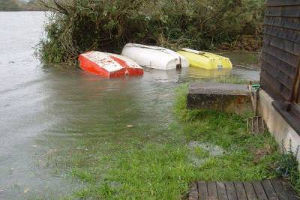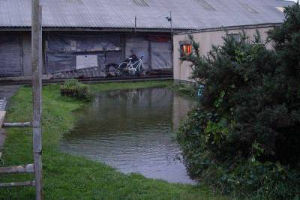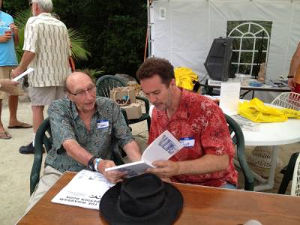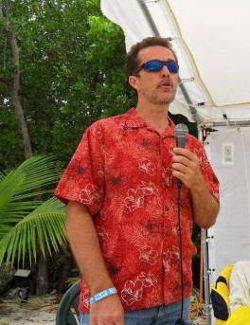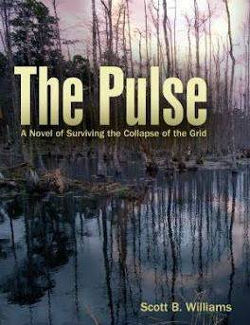This is my first writing of 2013. I spent the Christmas break and the first week of 2013 reading and keeping the fire going, while outside it rained and rained!
Hanneke, who is the ultimate crafts-woman, spent this time re-modeling part of our small living room, fitting much needed bookshelves for our ever-increasing library.
We live at the head of Restronguet creek, which is a sea arm off the Fal estuary, Cornwall. The floors of our house and studio workshop are about 40cm (1’4”) above the highest recorded water level (October 2004). Hence we are taking some precautions to keep our valuables high off the floor.
The weather systems of Northern Europe in the last months of 2012 produced exceptional rainstorms, which in turn produced large scale flooding in Britain. The flooding has been so serious that at last there is a grudging admission from the ‘climate change skeptics’ that perhaps we are witnessing a climate change. So we should be prepared for sea levels to start rising and tides to occasionally be exceptionally high.
In May 2012 Hanneke and I went to Florida to meet David Halladay of Boatsmith, our professional builder. We also attended the Florida Wharram Rendezvous where we met some of our builders and their boats.
There were some fascinating people at the rendezvous, but the one I wanted to meet particularly, was Scott B Williams. Scott had canoed in the 1990s from Florida Keys through the Caribbean to the Virgin Islands and written a book about this voyage, which he presented me with. Anyone who has read my book ‘Two Girls Two Catamarans’ will know of my connection and friendship with Dr. Hannes Lindeman, who in 1956 kayaked in a simple folding kayak across the Atlantic, from Las Palmas to Barbados. He survived this epic journey partly because I insisted he added a simple outrigger made of a car inner tube on one side of the canoe.
Many of the basic design elements of what is nowadays called a catamaran or trimaran are inherent in Early man's world-wide canoe form boats. For example, the design concepts of a modern sea kayak are based on the ancient Inuit/Eskimo designs.
So for many reasons I wanted to meet Scott. Of course it didn't surprise me that he was like most of my single-handed sailing heroes, quiet and modest, someone who only ‘opens up’ to another who has been where they have been. Scott told me he was writing a ‘survival’ novel that involves sailing in the Caribbean in a Wharram catamaran! He promised to send me a copy, when it was published. You can read a preview on Scott’s website.
So over Christmas as Hanneke was making the ‘high tide’ book shelves, I was reading Scott William's new book ‘The Pulse’. ‘The Pulse’ is what I call a disaster novel, of what happens after a massive solar electrical pulse wrecks all electronic devises in the World.
The first disaster novel I ever read was about 70 years ago, it was called ‘The War of the Worlds’ written by the great novelist, historian and political philosopher, HG Wells.
In the 1980s, when fears of an all-out Nuclear war were highest, a number of disaster/survival novels were written, the one I remember is ‘Long Voyage Back’, by Luke Rhinehart, which featured a trimaran (design unspecified) escaping to the Caribbean from an all-out nuclear war in the USA, where they meet a ‘Wharram’ catamaran along the way!
Disaster/survival novels and films are an expression of the deep fears some of us feel on account of the fragility or dangers of present day society, which could cause worldwide collapse and give rise to a few adventurous, ‘alternative’ humans to try to find a way to survive.
I'm not going to give away the plot of Scott's book, just advise you to go out and buy a copy, but I will reveal that a major player in the story is a Wharram 36' catamaran! The story takes place in the Mississippi Delta and the Northern Caribbean, the area Scott knows so well from his kayak explorations; it is a good read.
Our sailing plans for 2013 are still a little vague; Ruth at 92 years of age has to be cared for. The Spirit of Gaia refit should be finished in the Spring, Hanneke will be going out there again with some helpers, and some of our German sailing friends are organizing a Mediterranean charter on Gaia in the month of September.
In May a big meeting is being organized in Sète in the South of France, by the ‘Golden Oldies Multihull Association’ (to protect the heritage of historic offshore multihulls designed before 1988, including some old Dick Newick racing tris). We have been invited, either with ‘Spirit of Gaia’, or we may join the Pahi 63 ‘Largyalo’, which will be attending.
Here in Cornwall we have our 27' Amatasi to play with along our Cornish creeks and coastline, or maybe even across to France.
Happy Sailing in 2013 to you all.
- James Wharram

